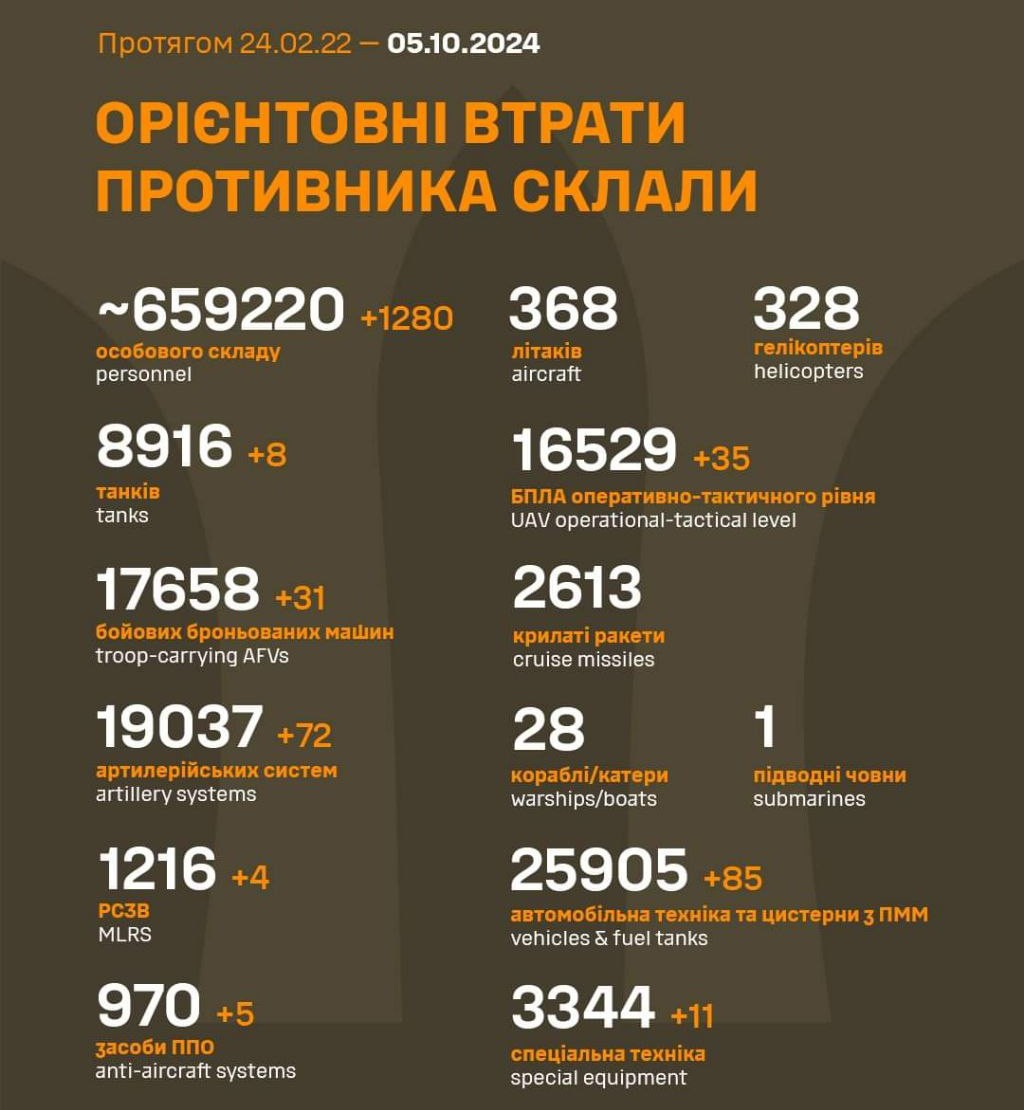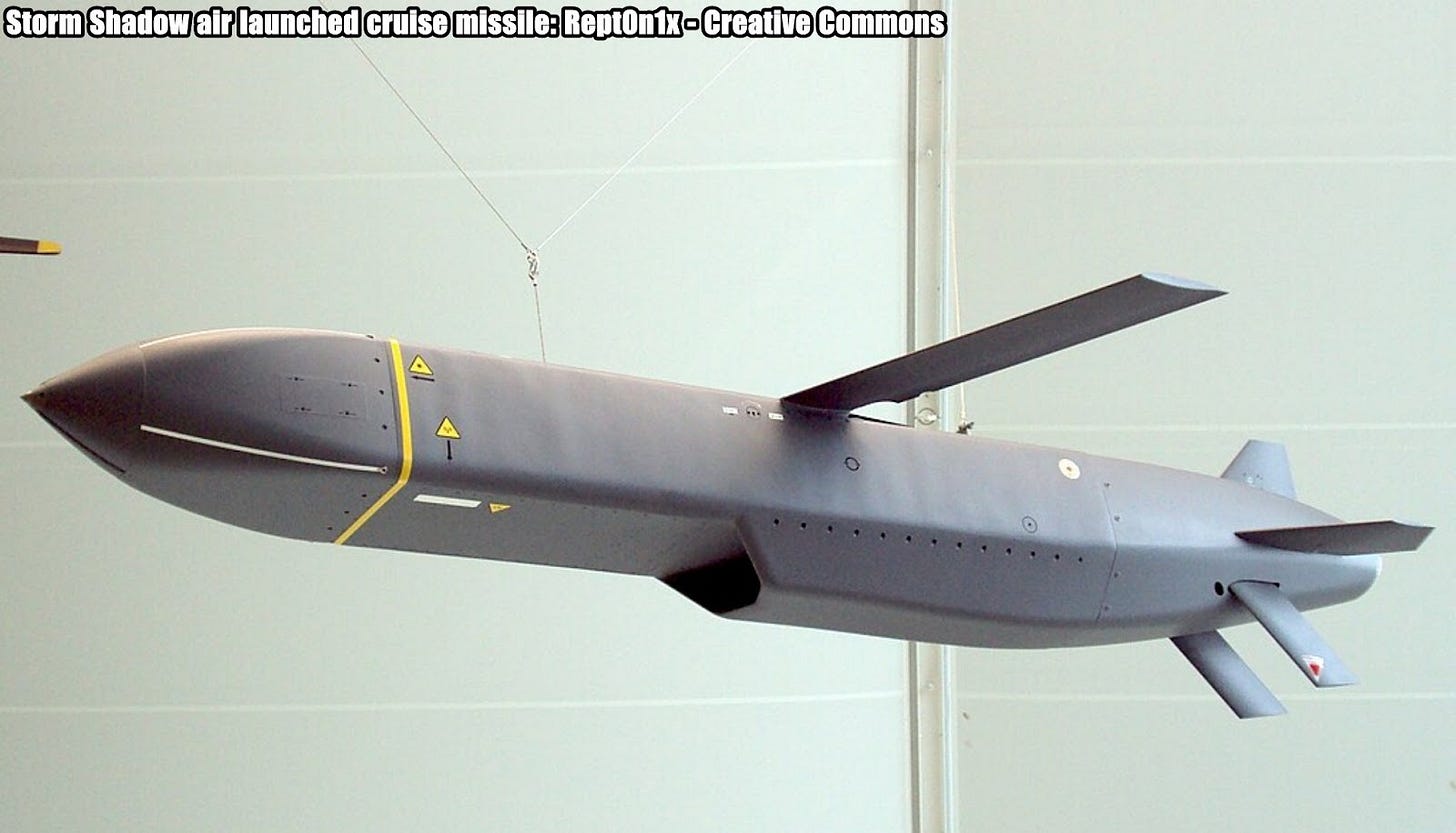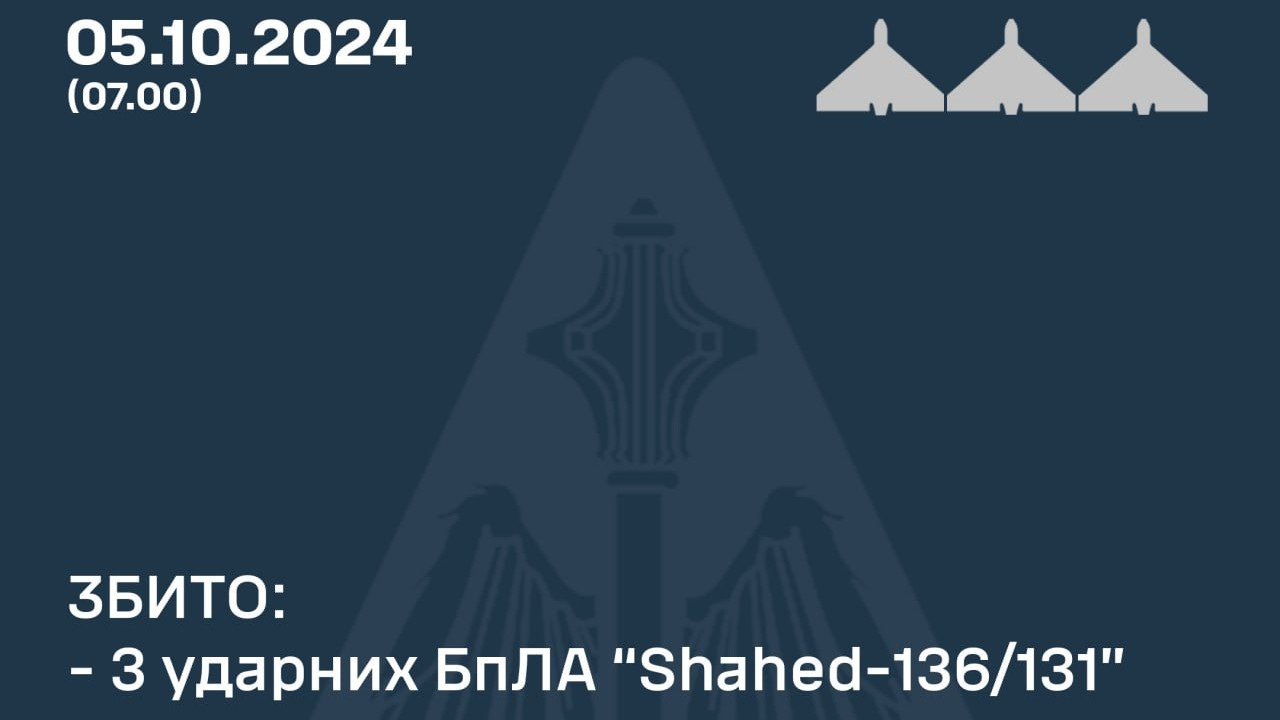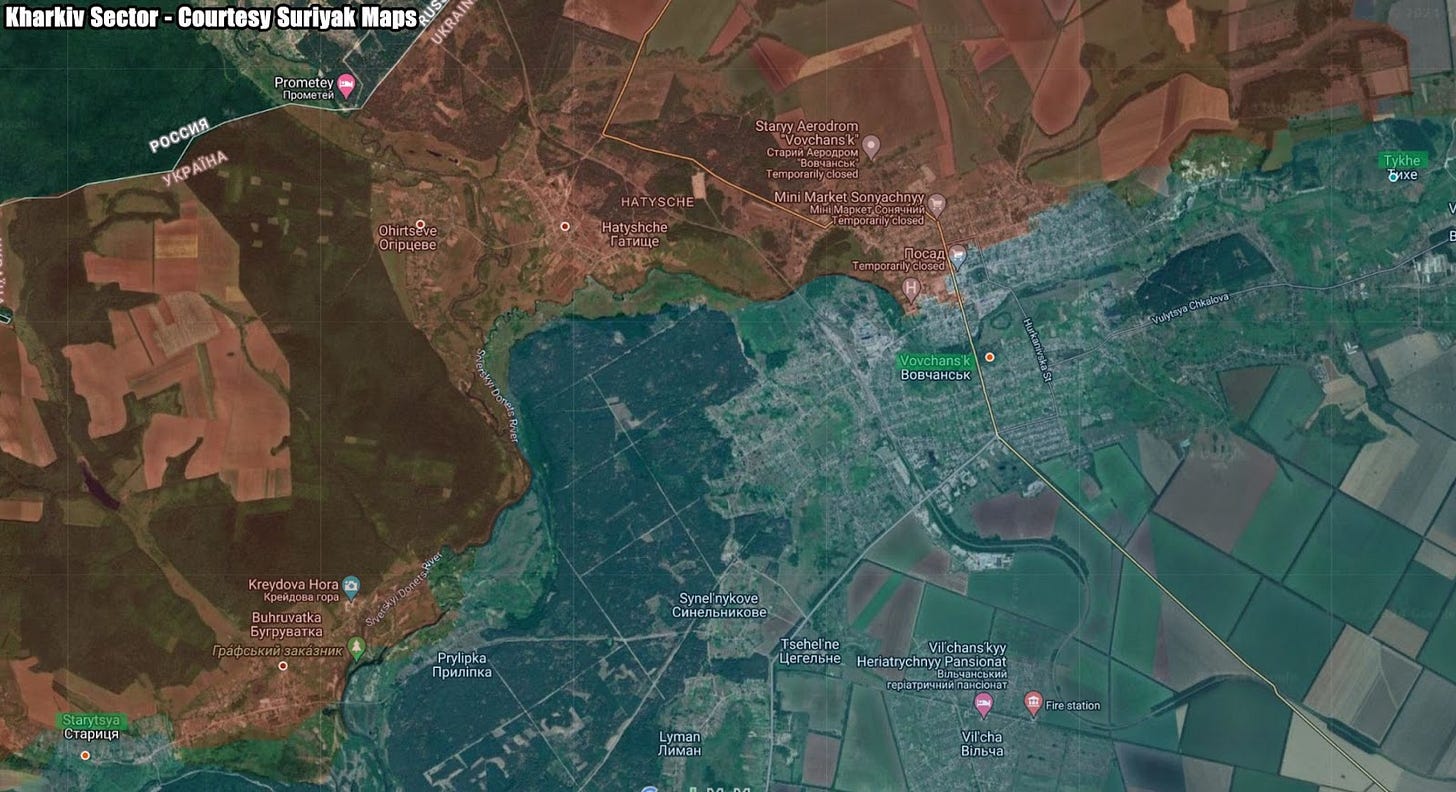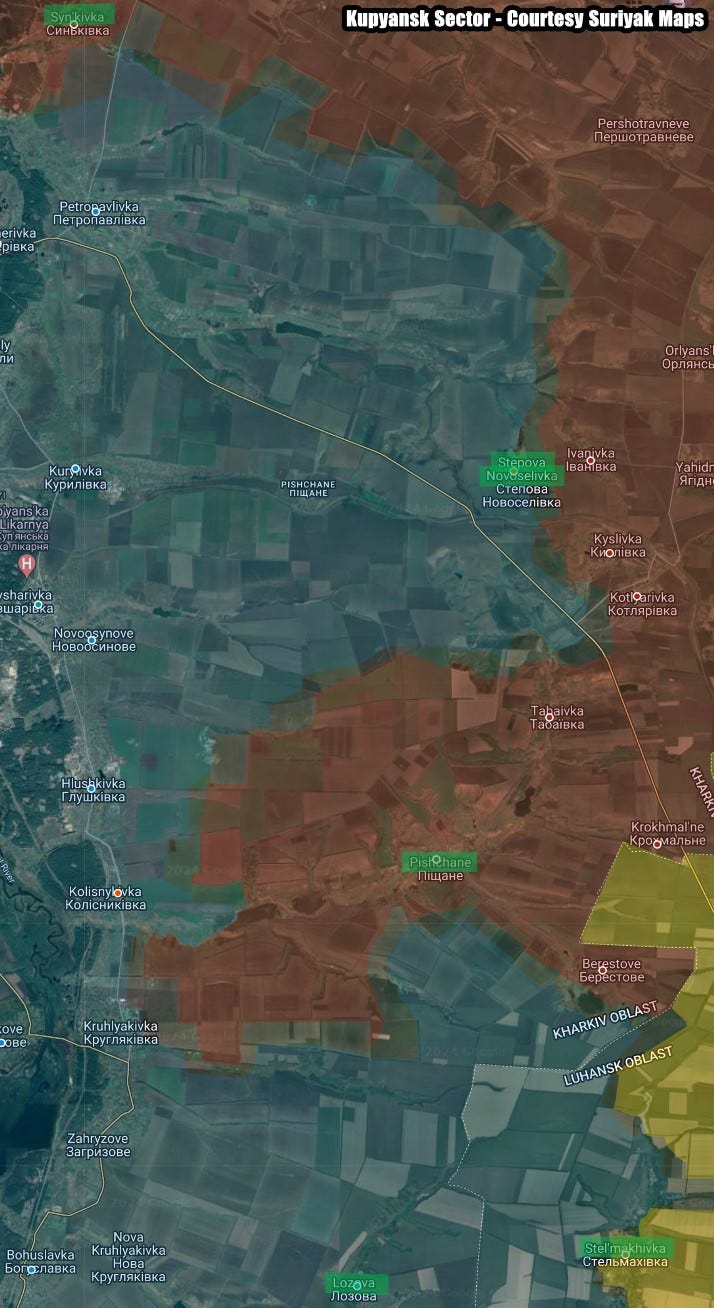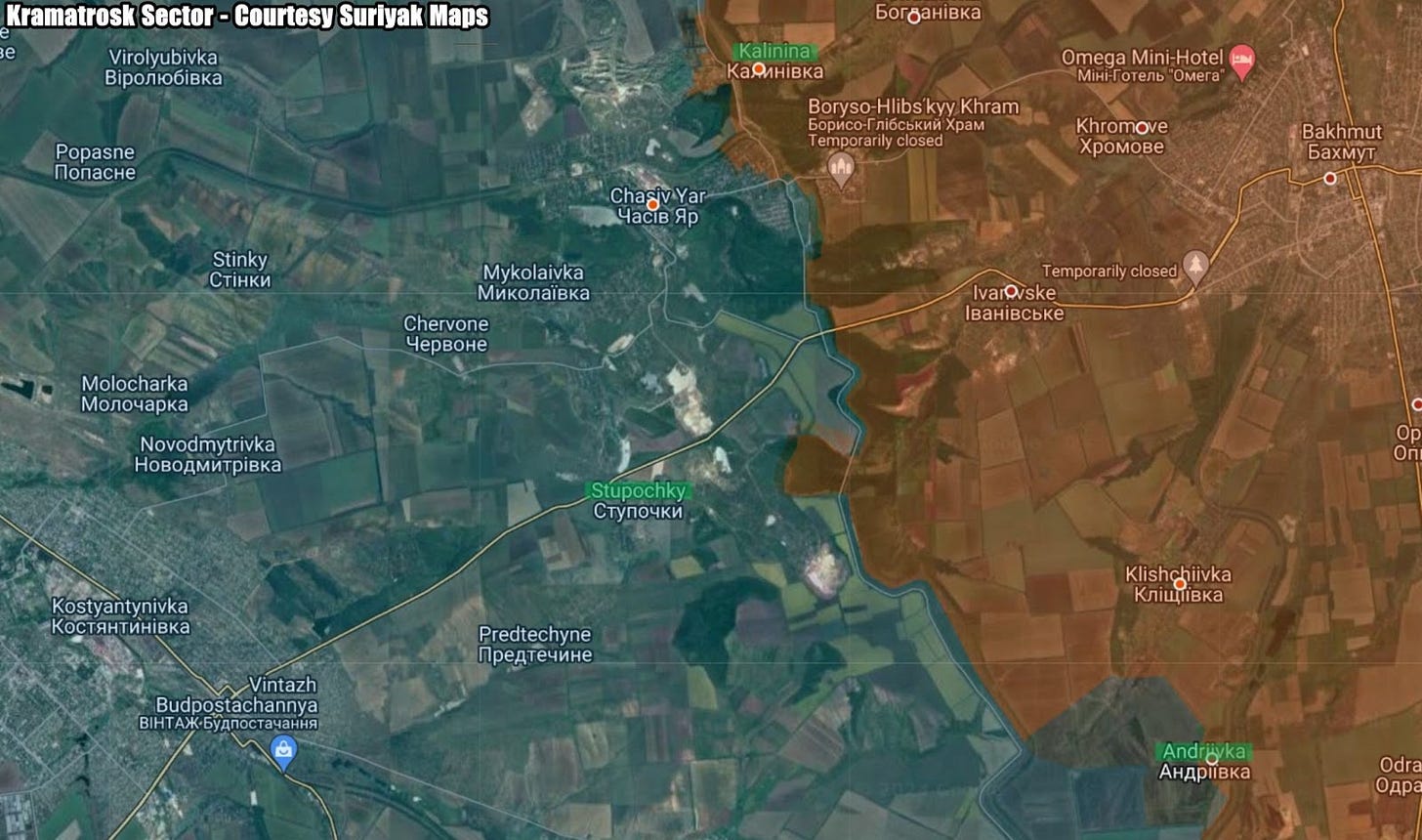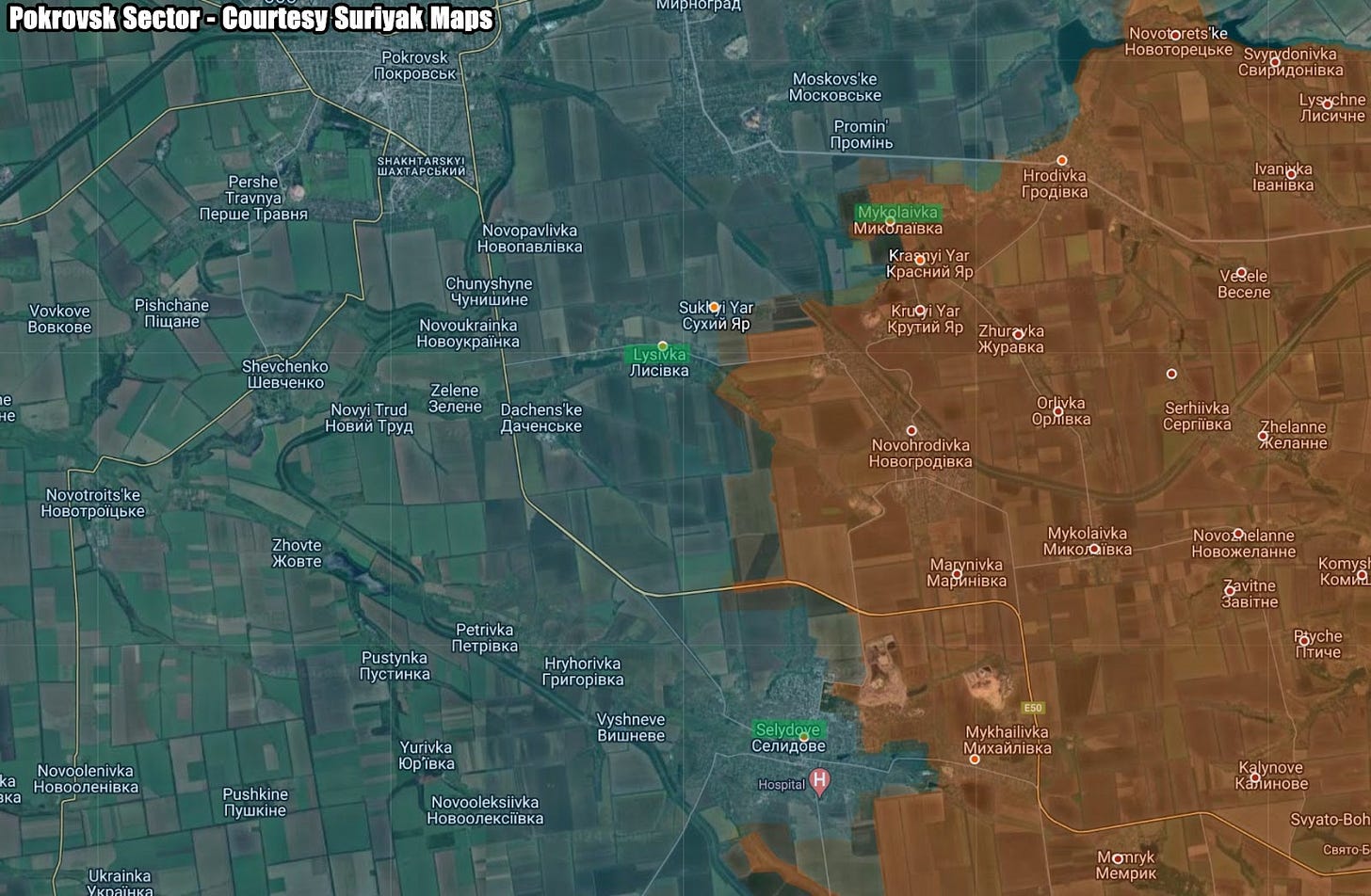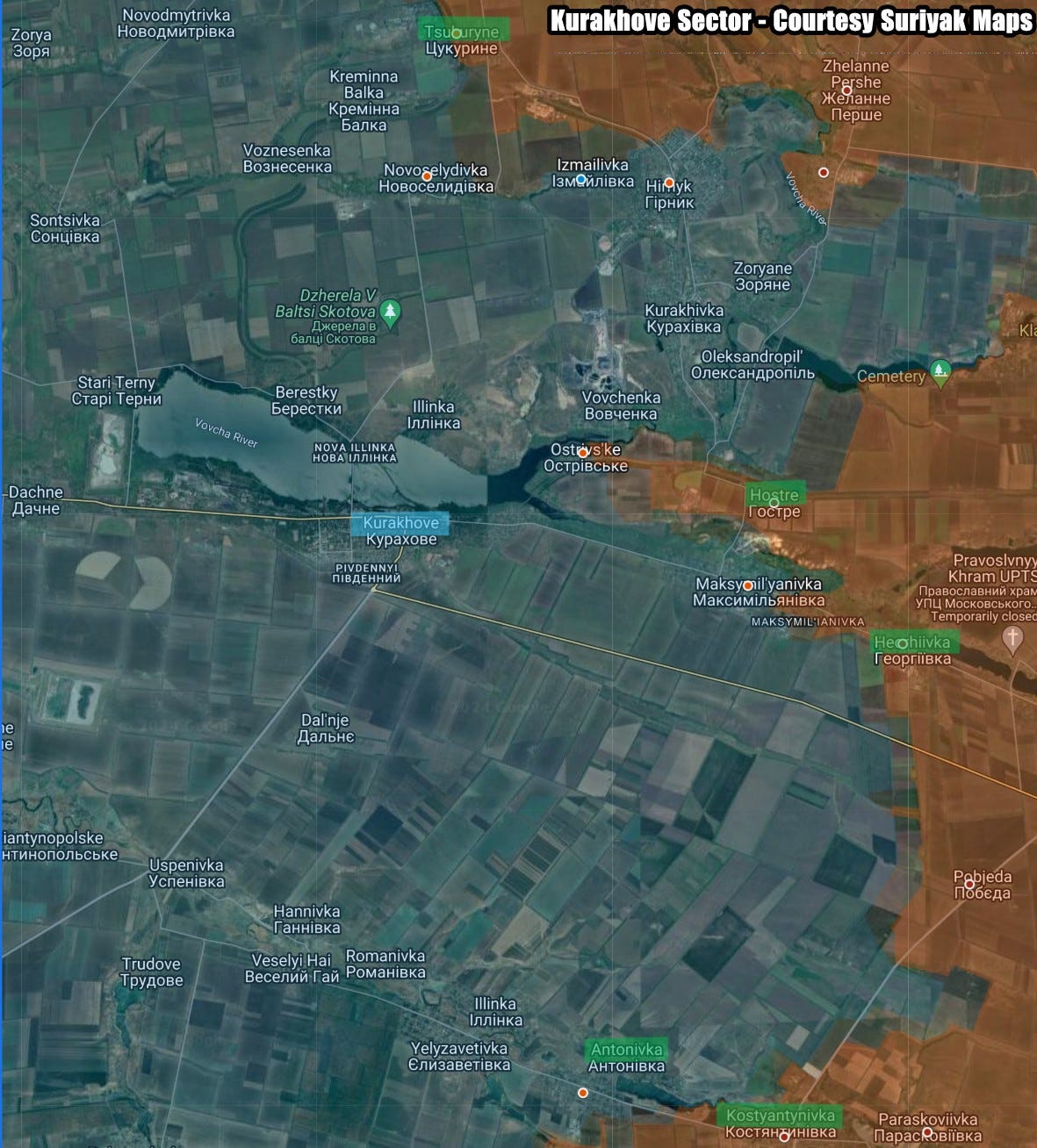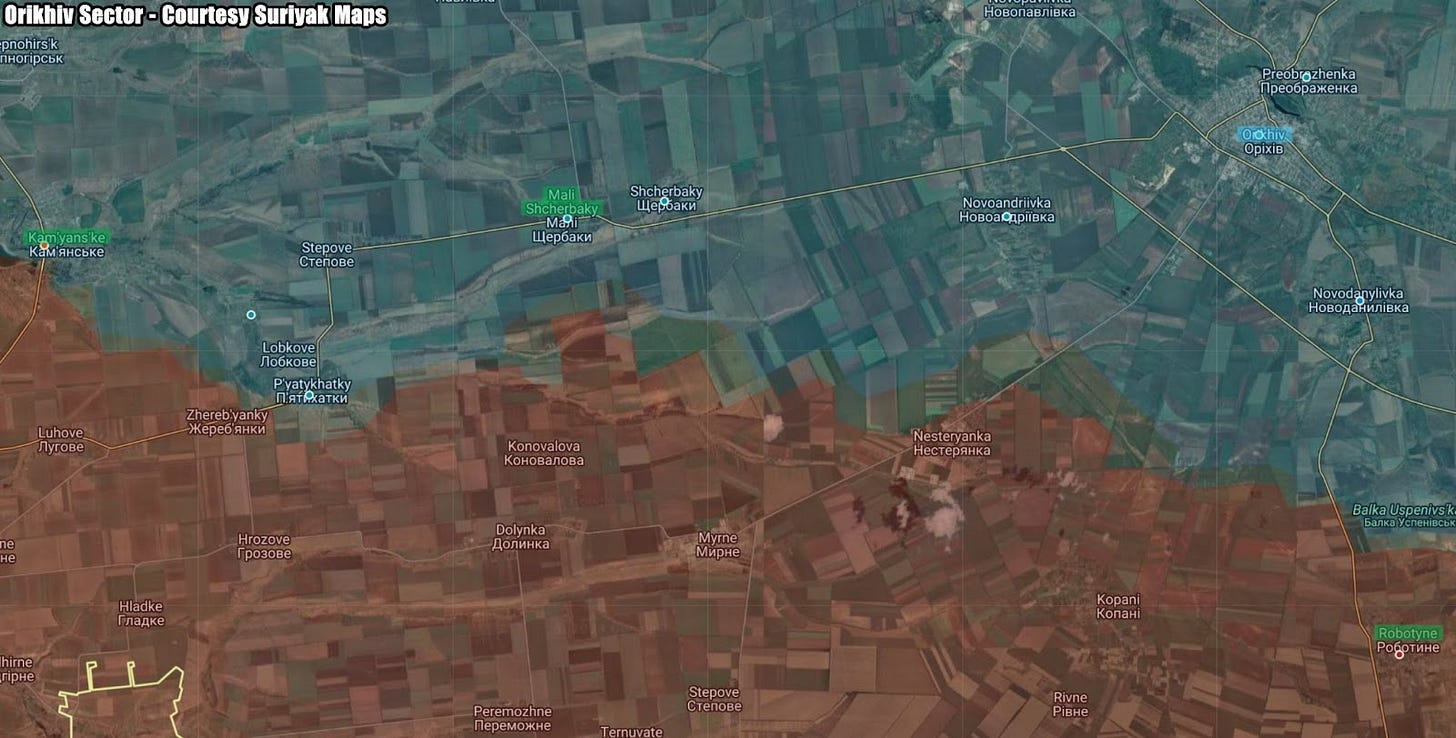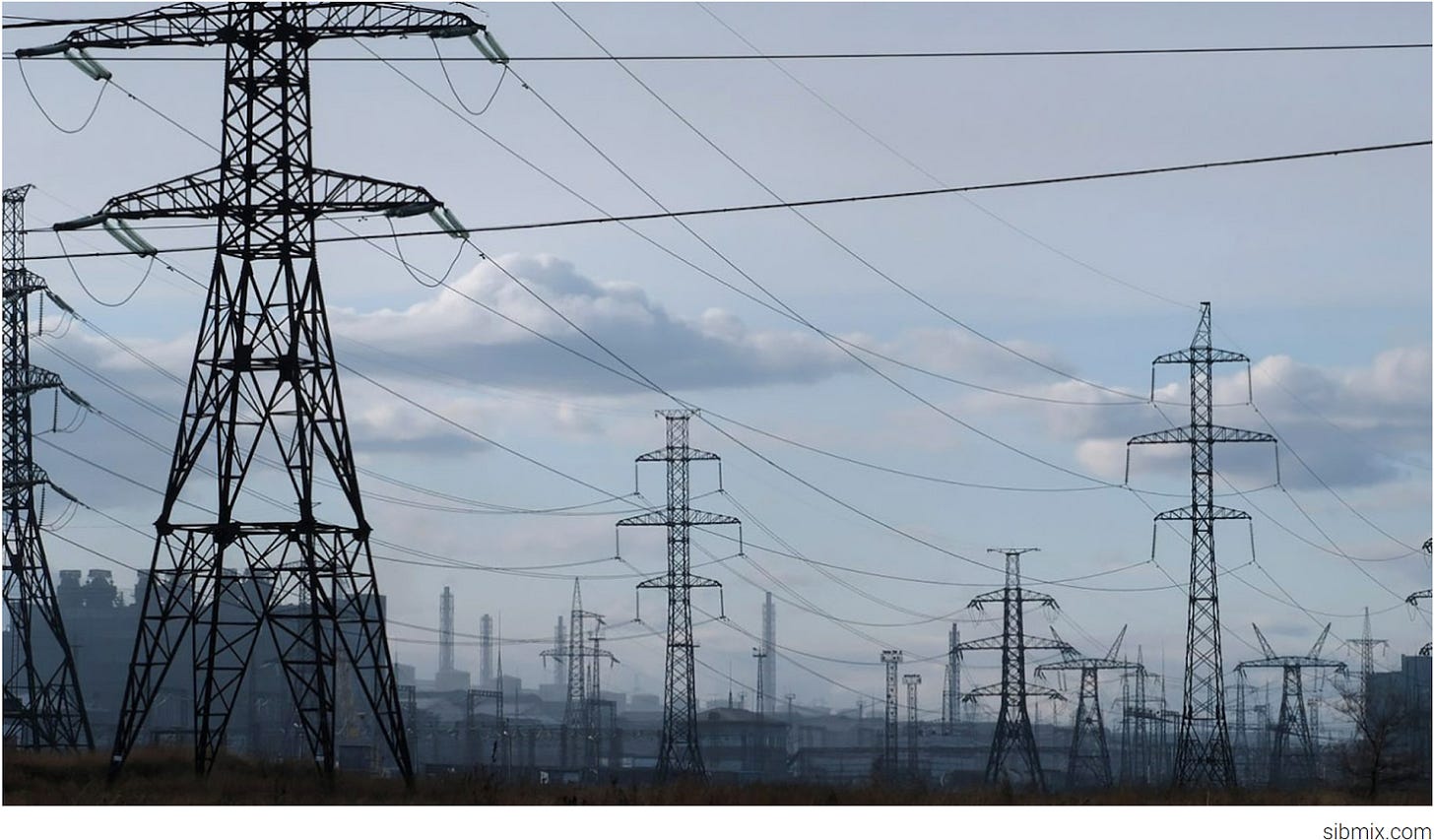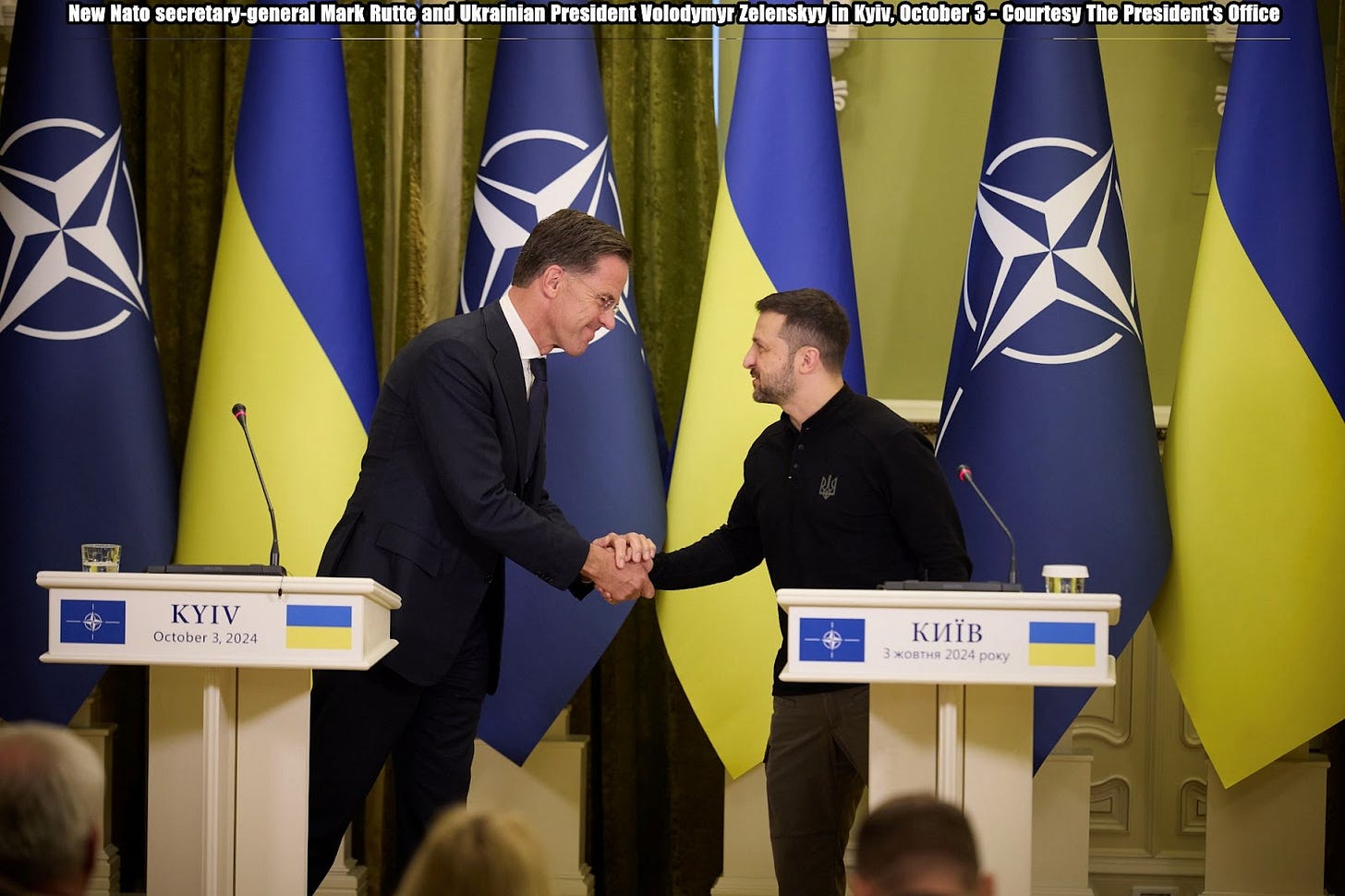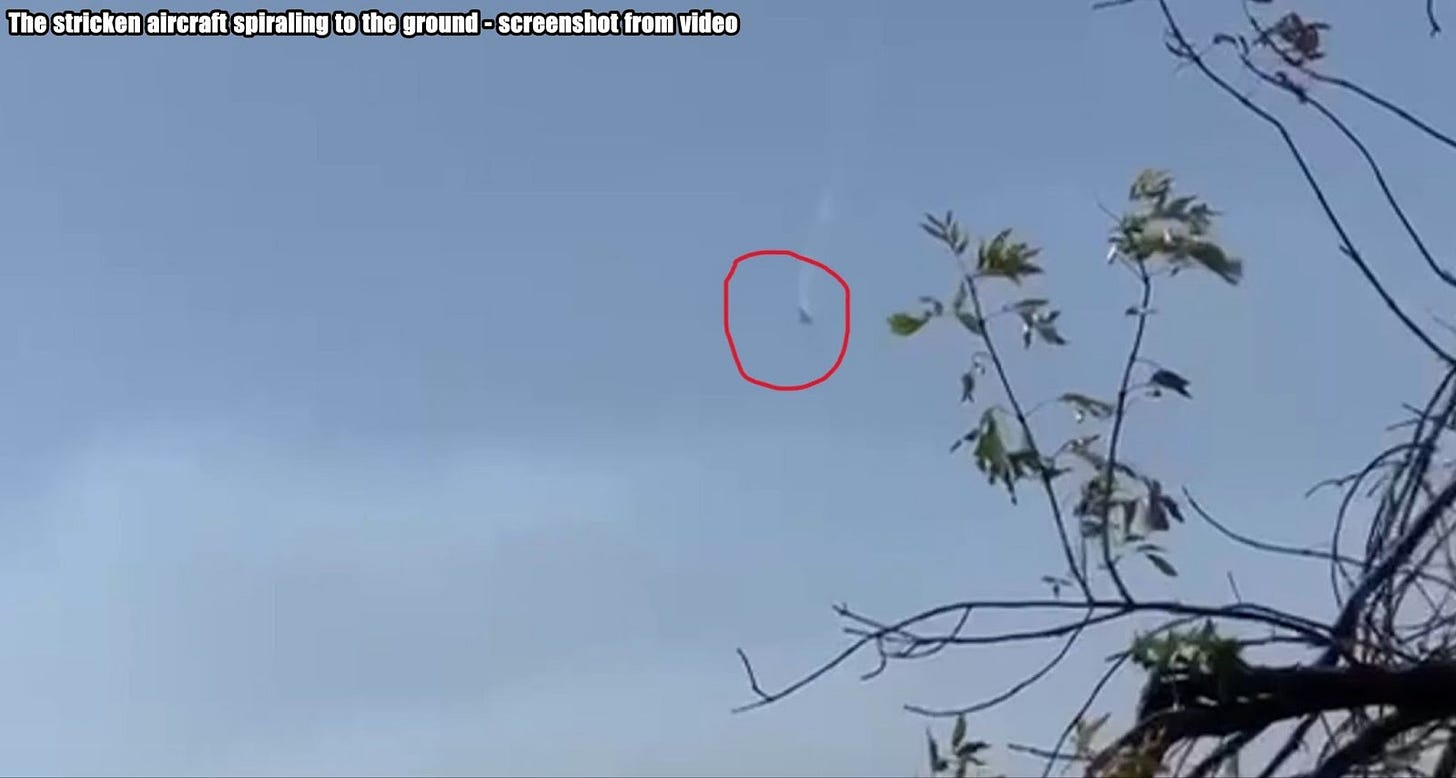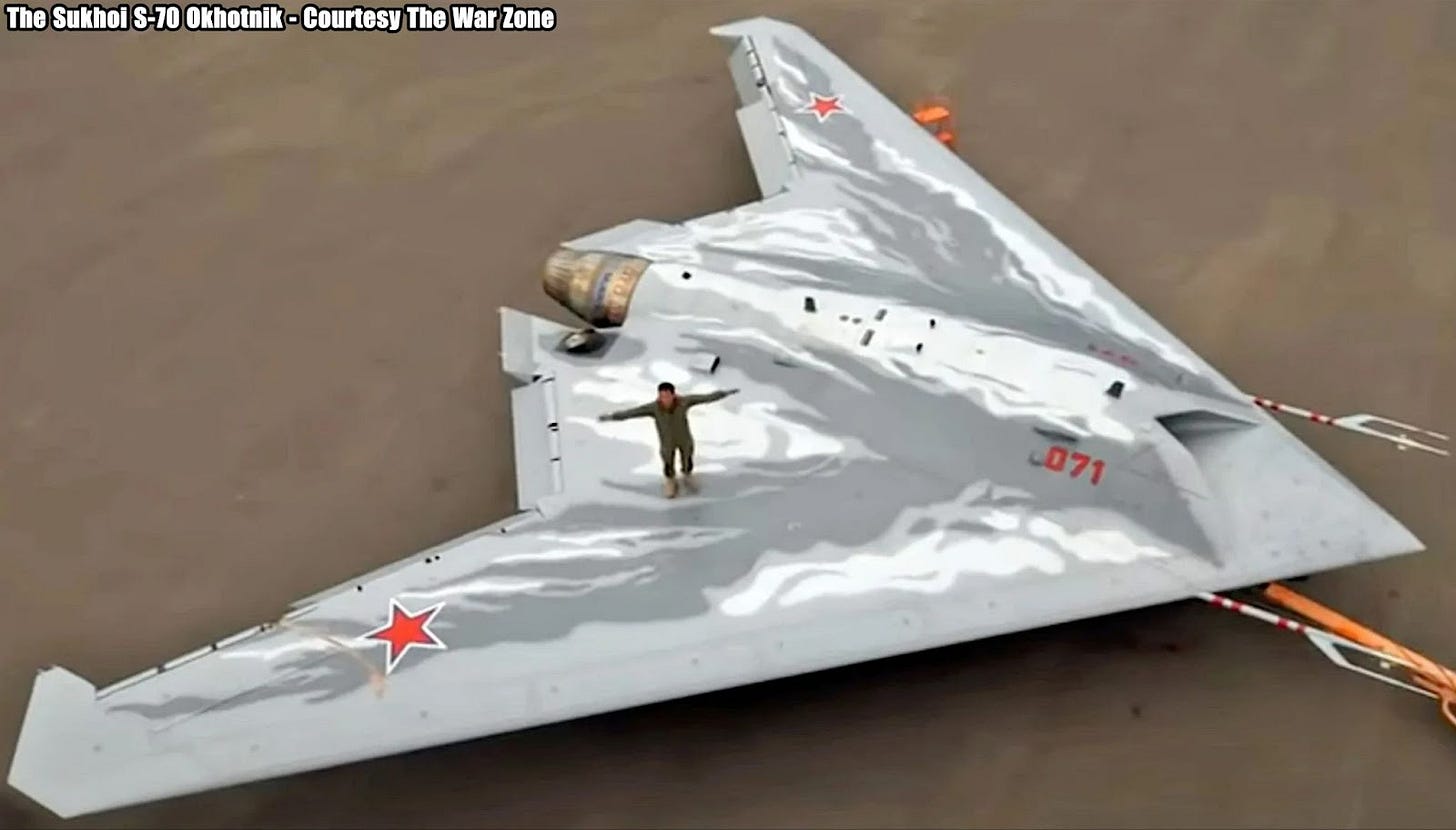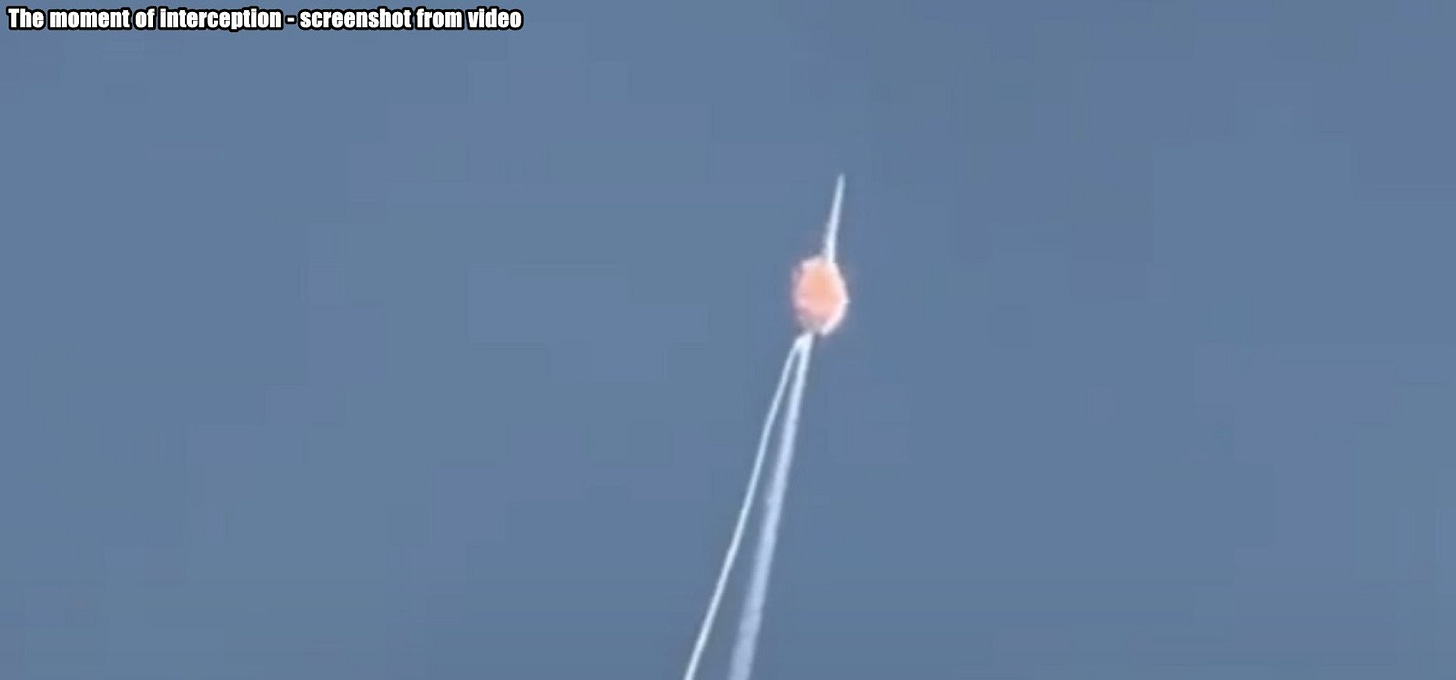Slava Ukraini! In early 2022 I began a Telegram channel aggregating news from a number of sources daily on the war in Ukraine. In June 2023 I began providing a daily draft for the Ukraine War Brief Podcast collecting news from over 70 sources daily, much of which formed the basis of the script. While the Podcast no longer exists I have continued to make this Brief available both on my own Substack and The People’s Media for those who wish to keep up with events on a daily basis.
All the latest news on the Russo-Ukraine War 6 days per week
ALONG THE CONTACT LINE
GSAFU Morning Report
The General Staff of the Armed Forces of Ukraine in its Operational Information update at 22:00 on Oct 4 stated that day 955 of the full-scale invasion of the Russian Federation against Ukraine was about to begin.
During the past day, 97 combat engagements took place. Over the past 24 hours, the enemy carried out; 61 air strikes, 630 drone strikes and more than 3,000 artillery strikes across the positions of Ukrainian forces.
At the same time, Ukrainian soldiers continue to inflict losses in manpower and equipment on the occupying troops, exhausting the enemy along the entire front line and continue to disrupt the plans of Russian occupiers to advance deep into the territory of Ukraine.
Ukrainian forces hit three Russian command posts
Ukrainian forces have struck three command posts of Russian invaders using Storm Shadow missiles and GMLRS rockets, the GSAFU announced.
"Successful strikes have recently been launched on the command posts of the 35th and 27th Motor Rifle Brigades and a command post of the 2nd Combined Arms Army of the Russian Armed Forces. The results of the strikes are being clarified," the post reads.
The strikes were carried out by units of the Ukrainian Air Force and missile troops and artillery of the Ukrainian Armed Forces, in cooperation with other units of the Ukrainian Defense Forces.
Storm Shadow missiles and GMLRS rockets were used in the attack.
Air Force Daily Report
On the night of October 5, 2024, the Russian occupiers struck with three Kh-59/69 guided air missiles from the airspace of the Kursk region - Russian Federation and occupied Crimea and 13 drones (strike UAVs) from the areas: Kursk - Russian Federation, Cape Chauda (Crimea ).
Anti-aircraft missile troops, mobile fire groups and units of the Defense Forces of Ukraine were involved in repelling the enemy's air attack. As a result of anti-aircraft combat, 3 enemy drones were shot down in Odesa region. 10 enemy unmanned aerial vehicles were lost in location in the north and south of the country, information about casualties and destruction was not received.
Also, as a result of active anti-aircraft missile defenses, the guided air missiles did not reach their targets.
The Russian Border Incursion
The Institute for the Study of War (ISW), a US based think tank, in its Oct 4 Russian Offensive Campaign Assessment assessed that Ukrainian forces continued ground assaults in Glushkovsky Raion west of the main Ukrainian salient in Kursk Oblast on Octr 4 but did not make confirmed advances.
Russian sources reported continued fighting near Veseloye (south of Glushkovo), and the Russian Ministry of Defense (MoD) claimed that Russian forces repelled Ukrainian attacks towards Novy Put (south of Veseloye).
A Russian milblogger claimed that Russian forces recently regained positions near Veseloye but have not fully recaptured Medvezhye (southeast of Glushkovo). Elements of the Russian 83rd Airborne (VDV) Brigade reportedly continue fighting in Glushkovsky Raion.
Fighting continued in the main Ukrainian salient in Kursk Oblast on Oct 4, but there were no confirmed changes to the frontline. Russian sources, including the Russian MoD, claimed that fighting continued near Kremyanoye and Olgovka (both east of Korenevo), Lyubimovka (southeast of Korenevo), and Plekhovo (southeast of Sudzha). Elements of the Russian 810th Naval Infantry Brigade (Black Sea Fleet [BSF], Southern Military District [SMD]) reportedly continue operating in Kursk Oblast.
The Khortytsia operational-strategic group
(Responsible for the northeastern part of Ukraine. )
Kharkiv Sector: Over the last day Ukrainian Defense Forces repelled 3 Russian attacks near Starysya, Vovchansk and Tykhe.
Kupyansk Sector: Russian Forces carried out 16 offensive actions against Ukrainian defensive positions near Synkivka, Stepova Novoselivka, Pishchane, Stelmahivka and Lozova. 2 engagements continue.
Lyman Sector: Russian Forces carried out 13 offensive actions against Ukrainian defensive positions near Druzhelyubivka, Hrekivka, Makiivka, Nevske, Novosadove and Torske. 3 engagements continue.
Siversk Sector: Russian forces carried out 3 unsuccessful assaults in the vicinity of Verkhnokamianske and Vyimka.
Kramatorsk Sector: Russian forces carried out 6 offensive actions near Kalinina, Stupochky and Andriivka.
Toretsk Sector: Russian forces carried out 11 offensive actions with air support near Toretsk and Shcherbynivka. 5 engagements continue.
The Tavria operational-strategic group
(Responsible for the central-eastern and southeastern part of Ukraine.)
Pokrovsk Sector : Throughout the day, Russian forces carried out 14 assault and offensive actions in this sector. The greatest activity was in the area of Mykolaivka, Lysivka and Selydove. 1 confrontation continues.
Kurakhove Sector: This sector was also very active. Russian forces, supported by aviation, made 25 assaults on Ukrainian positions near Tsukuryne, Hostre, Heorhiivka, Antonivka and Konstantinivka. 10 engagements are ongoing.
Vremivka Sector: There has been no significant change in the combat environment in the last 24 hours.
Orikhiv Sector: Russian forces made 4 attempts to advance against Ukrainian positions near Kamyanske, Mali Shcherbaky and Robotyne.
The Odesa operational-strategic group
(Responsible for Kherson, Qırım, (also known as Crimea) and the Black Sea.)
Prydniprovsk Sector: There has been no significant change in the combat environment in the last 24 hours.
TEMPORARILY OCCUPIED TERRITORIES
Nothing major to report.
THE HOME FRONT
South Ukraine NPP concluded an agreement on the construction of engineering protection
On October 2, the South Ukraine Nuclear Power Plant concluded an agreement for the construction of engineering protection of critical elements of the plant for 595 million hryvnias (14.3 million US dollars) Nikvesti reports.
The contract with PJSC Yuzhenergobud was concluded without holding open tenders. This is evidenced by the data in the Prozorro system.
According to the terms of the contract, the work must be completed by December 25, 2025. The terms of the contract are hidden due to the martial law.
Earlier, the International Atomic Energy Agency (IAEA) reported on the flights of Russian drones near the South Ukrainian nuclear power plant. In the IAEA report for Sep 19, it is reported that similar cases were recorded three times during the week.
An incident occurred on the night of July 16, an equipment failure occurred at one of the energy facilities, as a result of which the energy deficit in the system increased, as reported by Ukrenergo.
After that, social networks began to spread information that one of the power units was disconnected after the accident at the South Ukrainian NPP.
At the start of the full-scale invasion, 15 nuclear power units were operating in Ukraine, of which 9 units are now in the controlled territory at the South Ukrainian (three units), Khmelnytskyi (two units), and Rivne (four units) NPPs. Another six units are located at the ZNPP occupied by the Russian army.
RUSSIAN WORLD
Border instability creates tension in Russia’s Caucasus
A tentative border redraw edges Republics closer to instability, the Moscow Times reports.
Last month, Fortanga, an independent news outlet from the republic of Ingushetia in Russia’s North Caucasus, broke the news that the neighbouring republic of North Ossetia-Alania was plotting to redraw the two regions' shared border.
Documents obtained by Fortanga revealed that North Ossetian officials were hoping to incorporate into their territory parts of Ingushetia’s Dzheyrakhsky district, including a section of Stolovaya (Myat-Loam) mountain where large deposits of dolomite are located.
"There was a huge public outcry [in Ingushetia]. Everyone was talking about it, except perhaps the infants and the mute,” said Isabella Evloeva, journalist and founder of Fortanga.
Evloeva told The Moscow Times that many residents of Ingushetia, Russia’s smallest ethnic republic, took to community groups in messaging apps such as WhatsApp to express their outrage and pledge to stage protests if the border deal goes ahead.
“People calmed down a bit when they saw the responses from [Ingush] ministries and government agencies,” said Evloeva, referring to letters by heads of two of Ingushetia’s districts and several ministers obtained by Fortanga, whereby they declared the border redraw “unacceptable” and “impossible.”
“Many people in Ingushetia faced repression during the protests [against a similar border deal with Chechnya] in 2018 and 2019, which significantly weakened civil society and made them afraid to express their opinions, including on social media,” Evloeva explained. “But this issue forced people to speak out again,"
Siberian Region Declares ‘High Alert’ Over Electricity Shortages
Authorities in Russia’s Irkutsk region in southeastern Siberia introduced a state of “high alert” due to electricity shortages, according to a government decree published Friday. The Moscow Times reports.
The decree signed by Governor Igor Kobzev instructs local emergency services to develop additional plans for mitigating the consequences of widespread power cuts and check the preparedness of local emergency response teams.
Local authorities in the Irkutsk region were also instructed to ensure the availability of additional fuel reserves and backup power sources.
Earlier this week, authorities in the neighbouring republic of Buryatia introduced power supply restrictions that could leave as many as 30,000 residents of the capital Ulan-Ude and its suburbs without electricity, the independent news outlet Govorit NeMoskva reported.
Buryatian authorities claim that existing electricity infrastructure cannot handle growing demand as many residents have been forced to switch to electric heating due to the rising cost of firewood and other fuels.
The Siberian republic, which is frequently ranked among the poorest regions of Russia, would require at least 17 billion rubles ($178 million) to upgrade its existing energy infrastructure, according to Govorit NeMoskva.
NEWS WORLDWIDE
Half of Russia’s artillery shells are supplied by North Korea
Western intelligence sources claim that President Putin is dependent on weapons from Kim Jong-un to maintain advances in the eastern part of the country. The Times reports.
Half of the shells used by Russia — about three million a year — are being supplied by North Korea, according to western intelligence.
President Putin travelled to Pyongyang earlier this year to sign a defence pact with Kim Jong-un and the Kremlin has become dependent on the shuttered authoritarian state to maintain its advances in eastern Ukraine, intelligence sources say.
Although many of the shells are believed to be faulty, the sheer quantity has allowed Russia to make steady gains, most recently capturing the eastern Ukrainian city of Vuhledar.
Kyrylo Budanov, Ukraine’s head of military intelligence, warned in September that shipments of North Korean shells were tilting the war in Russia’s favour. “Our biggest problem from all these allies of Russia is from North Korea. Because with the volume of military products that they supply, they actually affect the intensity of the fighting,” he said.
During the initial years of the war, Russia’s allies appeared reluctant to actively supply Moscow with weapons. However, Putin’s efforts to build an anti-western coalition appear to be paying off and are having an impact on the battlefield.
The Times revealed in September that Iran has shipped 200 ballistic missiles to Russia, while China has hosted and assisted a Russian defence company in building long-range drones. Western officials believe there is “clear evidence” that China is playing an increasingly active role.
Despite the recent gains, Russia is suffering a high casualty rate of 1,200 soldiers a day in Ukraine, western officials assessed. It includes 480 casualties a day in the battle for Pokrovsk, the key garrison town in Donetsk that looks increasingly vulnerable to Russian capture.
It also appears that Russian generals are unable to simultaneously reconquer territory around Kursk and seize Pokrovsk without a mass mobilisation, something that Putin appears reluctant to do for fear of a political backlash. “They could mobilise if they wanted to. They chose not to,” a western official said.
West Germany model for Ukraine's NATO accession voiced in West
Among the ideas voiced in the West as possible scenarios for ending the current hot phase of the war in Ukraine and preventing a new one is its accession to NATO on the model of West Germany, which would provide Ukraine with security guarantees and deter Russia. An article in the Financial Times reports.
In the article, the publication collected the views of unnamed diplomats and public comments about possible scenarios for ending the war and Ukraine's accession to NATO.
The article notes that both in the West and more and more often in Kyiv, there is a growing belief that meaningful security guarantees from partners for Ukraine could be the basis for a certain agreement to end the current hot phase of the war. At the same time, Russia would retain the de facto control over the occupied territories, but they would continue to be considered legitimate territories of Ukraine, temporarily occupied and subject to diplomatic return in the future when the opportunity arises.
To be clear, neither Kyiv nor its supporters are proposing to recognise Russia sovereignty over the one-fifth of Ukrainian territory it has illegally grabbed since 2014. To do so would encourage further Russian aggression and severely undermine the international legal order.
What is envisaged is tacit acceptance that those lands should be regained through diplomatic means in the future. Even that, understandably, is a sensitive issue for Ukrainians, especially when presented as the basis of a compromise with Moscow. Ceding land to gain NATO membership may be the “only game in town”, as a western diplomat told us, but for Ukrainians it remains a taboo, in public at least.
What is being more openly discussed is the nature and timing of the security guarantees Ukraine will need to underpin a settlement.
In Washington Zelenskyy restated his pitch for accelerated membership of NATO.
The problem is the US is against moving beyond the agreed position of the alliance that Ukraine’s “future is in NATO”, that its accession is on an “irreversible path” and that it will be invited to join “when allies agree and conditions are met”. It fears that offering a mutual defence guarantee under the NATO treaty’s Article 5 before the war is over would simply draw in the US and its allies.
But some of Ukraine’s allies say this need not be the case. “There are ways of solving that,” Jens Stoltenberg, the Norwegian who stood down as NATO secretary-general this week, told my colleague Henry Foy in a farewell Lunch with the FT interview.
Stoltenberg pointed out that the security guarantees that the US provides to Japan do not cover the Kuril Islands, four of which Japan claims as its own but which are controlled by Russia after being seized by the Soviet Union in 1945.
He also cited Germany, which joined NATO in 1955, despite being divided. Only West Germany was covered by the Nato umbrella.
“When there is a will, there are ways to find the solution. But you need a line which defines where Article 5 is invoked, and Ukraine has to control all the territory until that border,” he said.
Most proponents acknowledge that Moscow would hate this idea. Sceptics fear it could provoke an escalation. NATO membership would guarantee Ukraine’s sovereignty and allow it to pursue its western orientation, goals that Russian leader Vladimir Putin is determined to destroy.
Other analysts argue West Germany is a bad parallel because its borders, though provisional, were recognised by both sides. In Ukraine they are being fought over every day.
There are many obstacles still on Kyiv’s NATO path. But the west patently lacks a strategy for Ukraine to prevail.
MILITARY & TECH
Russian S-70 Okhotnik UCAV shot down over Ukraine
The newest Russian heavy UCAV aircraft - the S-70 Okhotnik was shot down in Donbas. Ukrainian volunteer Serhii Sternenko released footage of the wreckage of this heavy drone. Militarnyi reports.
The Sukhoi S-70 Okhotnik [hunter in English] is a huge unmanned combat air vehicle, or UCAV. It is a jet powered aircraft with an internal weapons bay. As of 2021 it was reported that only one of these aircraft existed.
While built to resemble more modern stealth aircraft from the west it, like the SU 57 Felon is clearly not, with exposed seams and rivets.
It was shot down near the town of Kostiantynivka in the Donetsk region. Before the plane crashed, air-to-air missiles were seen in the sky. The moment of impact being caught on video from the ground. Later reports suggest the aircraft may have been shot down by the Russian’s themselves.
That’s it for today’s Draft folks if you would like to keep up with events in Ukraine daily please consider subscribing, its free!
Feel free to share this update with your friends. Heroyam Slava!







